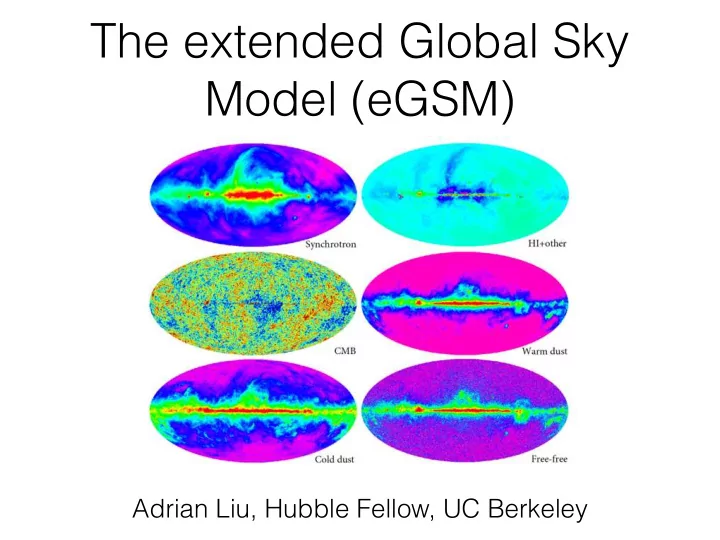

The extended Global Sky Model (eGSM) Adrian Liu, Hubble Fellow, UC Berkeley
The extended Global Sky Model (eGSM) project Adrian Liu, UC Berkeley Aaron Parsons, UC Berkeley Doyeon “Avery” Kim, UC Berkeley Josh Dillon, UC Berkeley Eric Switzer, NASA Goddard Max Tegmark, MIT Haoxuan “Jeff” Zheng, MIT/Intel
What does the sky look like in all directions at “all” frequencies? ??? ??? 10 MHz 85 MHz 408 MHz
How does one model the sky?
Global Sky Model v1 (de Oliveira-Costa et al. 2008, MNRAS 388, 247)
Take a wide selection of survey data…
…identify common regions…
…which are then used to train three principal component spectral templates…
…that are used to fit the spectra in every pixel of the sky…
…and are interpolated to produces maps of the sky at “any” frequency
Global Sky Model v2 (Zheng… AL … et al. 2017, MNRAS 464, 3486)
Take an even wider selection of updated maps…
…simultaneously fit for spectral and spatial information across the whole sky, even when there is missing data…
…now using six spectral components…
…to derive even higher quality maps.
…to derive even higher quality maps. By design, the eGSM does not explicitly model physical components
The principal components are not physical foreground components
Physical components can be identified by taking linear combinations that dominate at various frequencies
Blindly separated physical component maps from the eGSM
Favorable comparison to Planck data
Favorable comparison to Planck data
Blindly separated physical component maps from the eGSM
Global Sky Model v3 (Kim, AL … et al. 2017, in prep.)
Why three components? Why six components?
Why three components? Why six components? Too few components: inadequate fits to data Too many components: overfitting of data
Computing the Bayesian Evidence provides a way to determine the optimal number of principal components to fit
Computing the Bayesian Evidence provides a way to determine the optimal number of principal components to fit Zoubin Ghahramani Image credit:
Computing the Bayesian Evidence provides a way to determine the optimal number of principal components to fit Zoubin Ghahramani Image credit: Maximum likelihood
Computing the Bayesian Evidence provides a way to determine the optimal number of principal components to fit Zoubin Ghahramani Image credit: Maximum likelihood
Computing the Bayesian Evidence provides a way to determine the optimal number of principal components to fit Zoubin Ghahramani Greatest Image credit: evidence Maximum likelihood
Optimal number of principal components 13 2
Lots more coming soon to a Github repo near you! Already in progress • Position-dependent number of components. • Error bars in output maps. • Framework for incorporating global signal measurements. Commencing 2017 • Polarization maps (Switzer). • Inclusion of new global signal + map data.
Recommend
More recommend